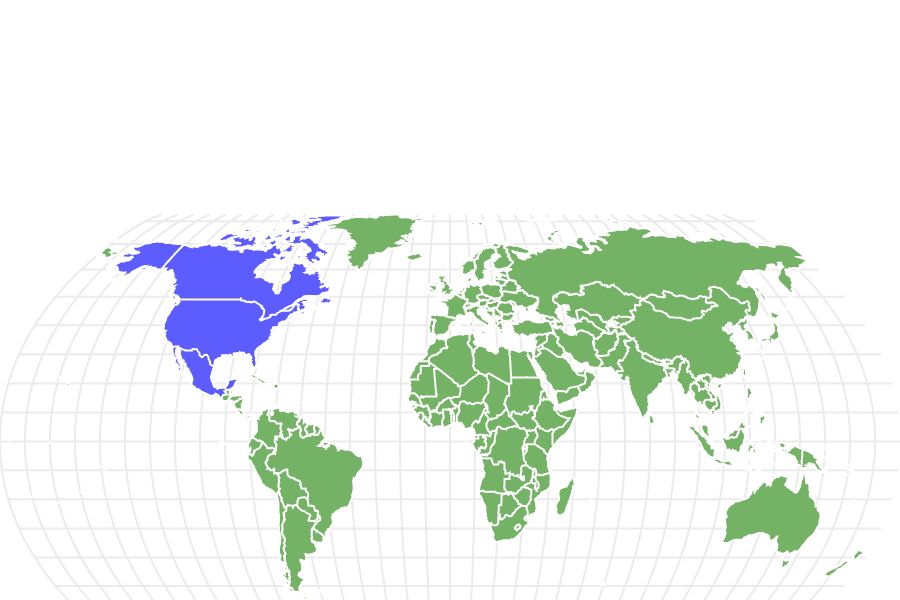Cooper’s Hawk
Accipiter cooperii
Eyes change color as they age
Advertisement
Cooper’s Hawk Scientific Classification
- Kingdom
- Animalia
- Phylum
- Chordata
- Class
- Aves
- Order
- Accipitriformes
- Family
- Accipitridae
- Genus
- Accipiter
- Scientific Name
- Accipiter cooperii
Read our Complete Guide to Classification of Animals.
Cooper’s Hawk Conservation Status
Cooper’s Hawk Facts
- Prey
- Birds, mammals
- Name Of Young
- Chicks
- Group Behavior
- Solitary
- Fun Fact
- Eyes change color as they age
- Estimated Population Size
- 100,000-1,000,000
- Biggest Threat
- Habitat loss
- Most Distinctive Feature
- Long tail and rounded wingtips
- Other Name(s)
- Chicken hawk, flying cross, striker
- Incubation Period
- 35 Days
- Litter Size
- 3-5
- Habitat
- Woodlands, forests
- Diet
- Carnivore
- Type
- Hawk
- Common Name
- Cooper's hawk
- Location
- North America
- Group
- Pairs
Cooper’s Hawk Physical Characteristics
- Color
- Brown
- Grey
- White
- Skin Type
- Feathers
- Lifespan
- 12 years
- Weight
- 0.45kg-0.7kg (1lbs-1.5lbs)
- Length
- 0.35m-0.46m (1.1ft-1.5ft)
- Age of Sexual Maturity
- 2 years
- Age of Weaning
- 1 month
View all of the Cooper’s Hawk images!
“The Cooper’s hawk is the stealthy and agile aerial predator of the American woodlands.”
Cooper’s hawk is a bird known by many different names throughout North America, including the chicken hawk, striker, and flying cross. It is a medium-sized hawk that is often identified by its proportionally large head, black-banded tail feathers, and hunting habits under the canopy of wooded or forested areas. Even expert observers can easily confuse the identification of these hawks with similar related American hawks like the sharp-shinned hawk and northern goshawk. They spend most of their time in the canopy of densely wooded areas where they use their remarkable agility to stalk and ambush elusive prey species. They mostly eat smaller birds, but can also prey on mammals and insects.
3 Incredible Cooper’s Hawk Facts!
- Familiar Ground: While they rarely use the same exact nesting site twice, adults generally return to the same breeding ground each year.
- Early Bird: These hawks prefer hunting in the early hours of the day and are rarely seen in the afternoon or evening.
- Changing Eyes: Most Cooper’s hawk chicks hatch with yellow-green eyes that slowly turn orange and then red when they get older.
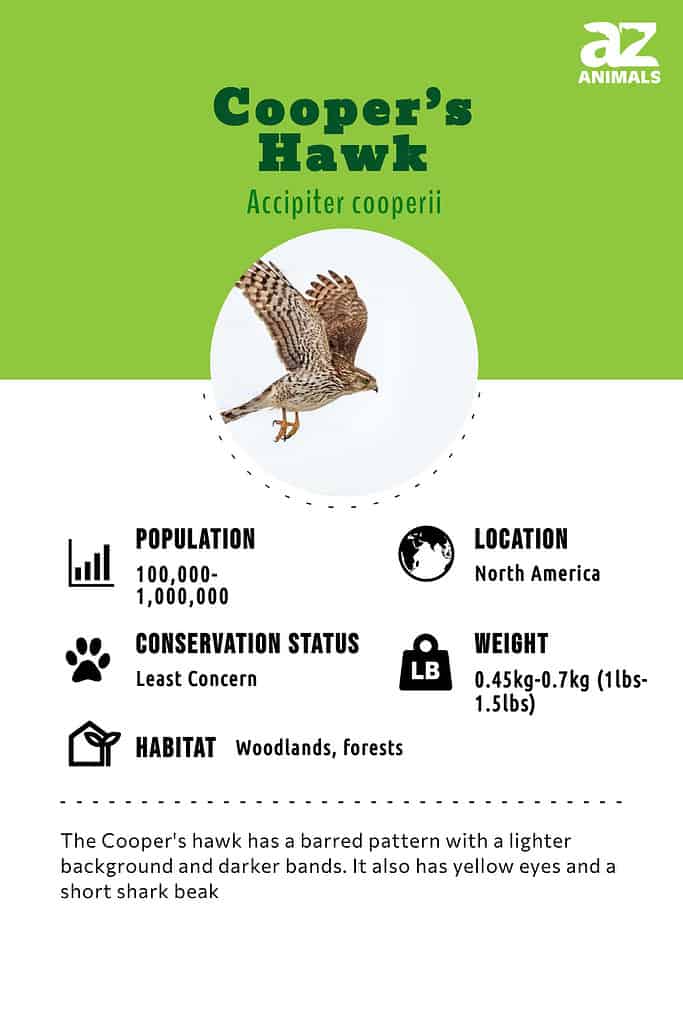
Scientific Name

The Cooper’s Hawk is a member of the Accipitridae and is related to other hawks, eagles, kites, and harriers, as a result
©Richard G Smith/Shutterstock.com
Cooper’s hawk has many common or local names, including chicken or hen hawk, quail hawk, swift hawk, big blue darter, striker, and flying cross. The species’ scientific name is Accipiter cooperii and they are members of the Accipitridae family in the Aves class. The name “Cooper” and “cooperii” are both derived from the original name given to the species by a French ornithologist who discovered it in 1828. He named it after the American naturalist William Cooper, his friend and contemporary, who also traversed the Americas to collect sample specimens of various animal species.
Appearance
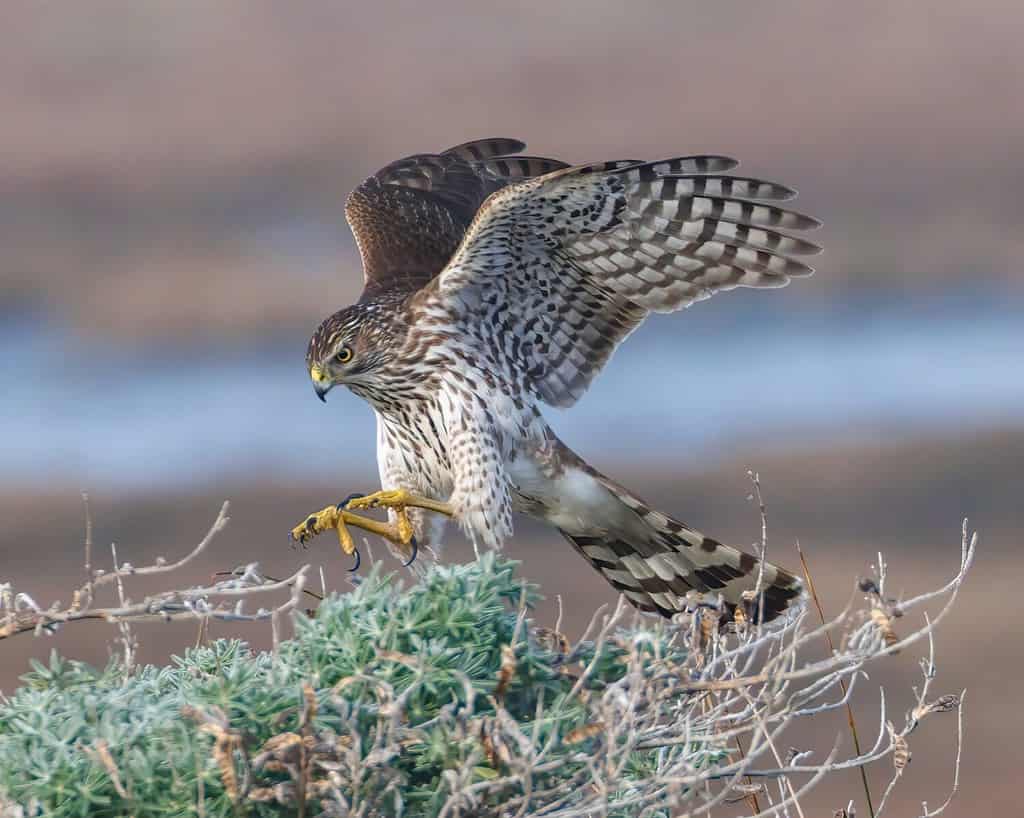
The Cooper’s Hawk has very long tail feathers which help it maneuver skilfully in the air
©J. S. Fisher/Shutterstock.com
The Cooper’s hawk is a bird with several key physical characteristics that are all adapted to increase their maneuverability, agility and stealth. They have relatively short wings compared to their size, with an average wingspan of about 33 inches. Their wings have distinctly rounded tips. They have very long tail feathers relative to wingspan and body size, which helps them precisely control their movements as they navigate around trees and make sharp mid-air turns to keep up with smaller, evasive birds. The hawk also has a relatively large head as well as a strong beak and talons that help it achieve a firm grip on its prey.
This medium-sized species ranges from 14 to 20 inches in total length, but this doesn’t stop them from targeting birds of comparable size. The average weight for a mature bird ranges from 1 to 1.5 pounds, with females being routinely larger than their male counterparts. In the United States, birds found nesting west of the Mississippi River is generally smaller than those east of the river. Body feathers range in color but are usually brownish or bluish-gray on the back and wings with a much lighter underbelly. Darker barring is usually seen across the underside.
Behavior
Unlike falcons and many of the more active raptor species, Cooper’s hawk is a patient and prudent predator that spends a lot of its time waiting in woodland canopies. They watch and listen for potential prey stealthily, relying on their camouflaged feathers to conceal them in the branches of trees. They prefer to ambush their prey and take them by surprise, but they are capable of remarkable burst speed to make a capture. However, they are usually unwilling to engage in lengthy pursuits and may break off the chase if their prey keeps distance for long enough.
This species is an early riser and is more active in the dawn and morning hours than the afternoon. They also spend a substantial portion of their time preening on their roost to keep their feathers in perfect condition as they wait for prey. While they spend most of their time among the upper branches of trees, they sometimes take to the ground to hunt smaller mammals or take a drink from a secluded water source. Like many predatory birds, this hawk rarely makes a call or sound except as a warning against threats.
Habitat
Cooper’s hawks hunt almost exclusively in wooded areas with a tendency to stick to deciduous and mixed forests. They have a strong preference for temperate climates and their native range extends from southern portions of Canada through the entire continental United States to the northern portions of Central America. While they may remain in their local environment year-round, birds that live in Canada and the northern US tend to migrate south annually.
Their smaller wings and long tail feathers are adaptations that help them navigate around trees and chase unpredictable prey. While they are capable of short bursts of speed, their body isn’t suited for diving or long pursuits like those of many other raptor species. Their dark and barred coloration also provides effective camouflage among the branches and treetops where they spend much of their time.
Diet

The Cooper’s Hawk is rather fond of hunting domestic fowl although it is also partial to bats, reptiles, and rodents
©Aussiemandias/Shutterstock.com
Cooper’s hawk is an opportunistic carnivore that targets live prey and has a decent range of possible targets. Reported cases of these hawks consuming carrion are extremely rare. They have a definite preference for certain types of bird species as prey, but their diet can become flexible when the need arises.
What does the Cooper’s hawk eat?
With common names like the hen hawk, quail hawk, and chicken hawk, Cooper’s hawk has an obvious preference for eating chickens, quail, and other plump fowl. They have long been a scourge of farmers, especially in centuries past, who had to worry about these hawks targeting their coops. Bats are another likely prey candidate for this hawk, as are most small to mid-sized bird species. Snakes, frogs, and various land mammals, including squirrels and chipmunks, may also fall prey to hungry hawks.
Predators and Threats
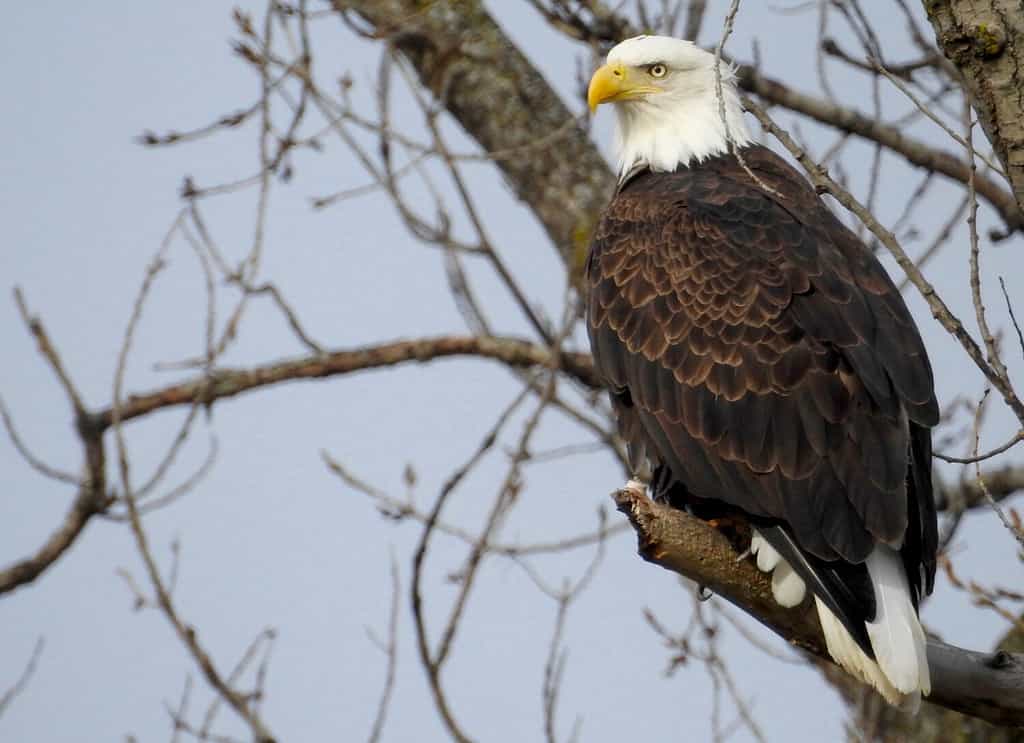
Eagles can constitute a source of danger for Cooper’s Hawks
©Marcy Herrick/Shutterstock.com
This hawk is generally near the top of the food chain in its local environment, with potential predators limited to eagles and other larger birds. One of the biggest historical threats to the Cooper’s hawk was the widespread use of pesticides. These toxic agents infiltrated the food chain and reached high concentrations for hawks, falcons, and other predatory animals. Limitations in the use of these pesticides have allowed for some rebound and they are considered a species of least concern in terms of conservation.
The species is not a source of food for humans, but they were once considered a fair target for shooting by people who wanted to protect their domesticated animals and local game birds. This practice was popular in the first half of the 20th century but was curtailed when the dwindling hawk population prompted conservation laws protecting them. Even though active shooting is now a minimal concern, these hawks are still sometimes hunted or poisoned to defend poultry or fowl.
Even though their overall population is relatively stable, the Cooper’s hawk currently faces the ongoing threat of habitat loss. Logging activities and general encroachment by human development are slowly limiting their local ranges and forcing them into lower-quality environments. They have adapted to urban and suburban habitats with some success, but researchers are unsure of the long-term consequences or viability of this transition.
Reproduction and Life Cycle
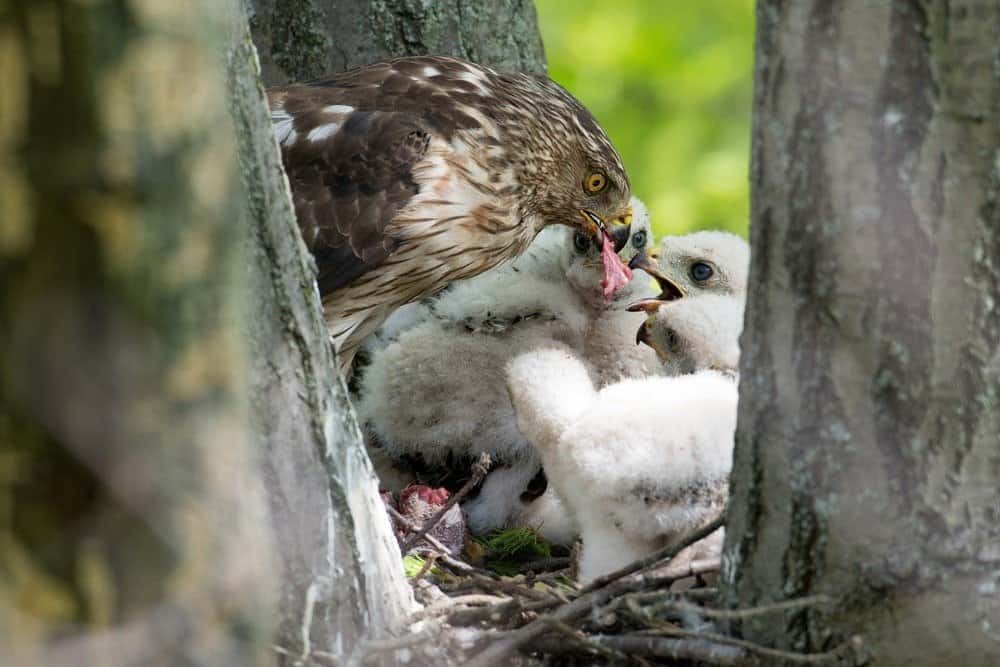
Adult Cooper’s hawks take parental care very seriously with the male responsible for obtaining food for his newly expanded family
©Tony Campbell/Shutterstock.com
These hawks tend to have only one mate per season, like most predatory birds, but this isn’t always the case. Mature adults also tend to select prospective mates of comparable size and pairings of larger individuals typically lay their eggs a bit earlier in the year than smaller birds. Courtship rituals are flexible and may involve just the male, just the female, or both at the same time. Mutual sky circling is a common occurrence alongside sky dances that may include arching, flaring, and other displays.
Breeding and nest building usually takes place between February and March. In most cases, both members of the pair remain with the nest to gather food and defend their young. The nests are generally bulky structures made from sticks, bark, and assorted greenery. Hawks defending the nest may make a “kek” call to warn their partner when they feel threatened by a potential predator.
Females generally lay 3 to 5 eggs that have a bluish-white shell. Both genders participate in incubating the eggs for about 35 days before they hatch. The chicks remain in the nest for 4 to 5 weeks before they start learning to fly. Wild birds have a life expectancy of 8 to 10 years, with the highest risk of mortality in the first year. The oldest known specimen tracked by banding reached an age of 20 years and 5 months.
Population
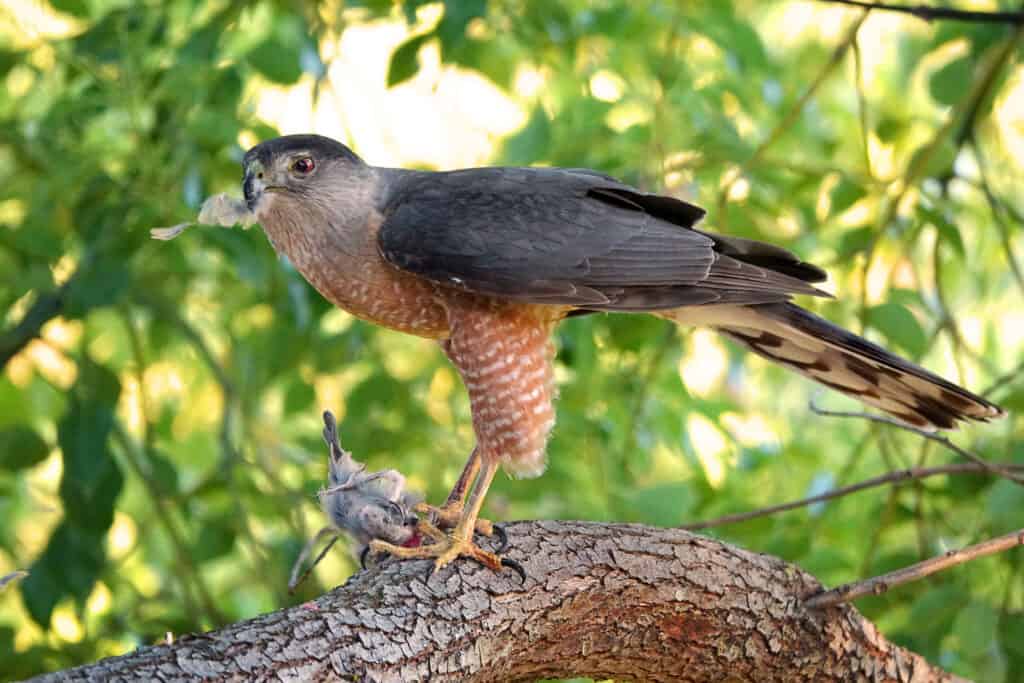
Cooper’s Hawks are at risk of the destruction of their natural habitat
©iStock.com/Linda Koski
Despite intense persecution by humans and population reduction from pesticide exposure in the 20th century, the Cooper’s hawk has made a strong comeback. Their numbers are now estimated to be between 100,000 and 1 million across their entire native range and conservationists believe this number is currently stable. However, the continued destruction of habitat and threats to the population of desirable prey species could cause problems for them in the years ahead.
View all 235 animals that start with CCooper’s Hawk FAQs (Frequently Asked Questions)
What is a Cooper's hawk?
This hawk species is a predatory bird found through the United States, Mexico, and southern portions of Canada. They have an average wingspan, rounded wingtips, and long tails for their size, which help them maneuver around trees in their woodland and forest habitats.
Are Cooper's hawks carnivores, herbivores, or omnivores?
These raptors are true carnivores that prefer to eat other birds. However, they have been known to target insects when desperate and there have been isolated reports of birds consuming carrion.
What does a Cooper's hawk look like?
The Cooper’s hawk has brown to blue-grey feathers covering most of their body, with darker markings and feathers around the head. The underside is generally white or a much lighter color with distinctly darker barring from top to bottom. They have a hooked beak, like many birds of prey, and mature adults usually have striking dark red eyes.
What does a Cooper's hawk sound like?
These hawks don’t make many sounds throughout the daily routine. Their call can be described as a repetitive “kek” sound and is usually employed in response to threats.
How big is a Cooper's hawk?
This species is a medium-sized hawk that is average in almost every way aside from its particularly long tail feathers. Adult body length ranges from 14 to 18 inches and weight is between 1 and 1.5 pounds. The average wingspan is about 33 inches from tip to tip.
What do Cooper's hawks prey on?
Even though they have a distinct preference for certain types of fowl, these hawks may target all kinds of animals in their native habitat. Many smaller bird species are possible targets, as are smaller mammals, reptiles, and even some larger insects.
Is it illegal to kill a Cooper's hawk?
Federal law in the United States protects Cooper’s hawk, along with many other predatory birds, from kill or unsanctioned capture. Many states also have their own legislation regarding punitive measures for people found poisoning, shooting or otherwise disturbing these animals.
What Kingdom do Cooper's Hawks belong to?
Cooper’s Hawks belong to the Kingdom Animalia.
What phylum do Cooper's Hawks belong to?
Cooper’s Hawks belong to the phylum Hemichordata.
What class do Cooper's Hawks belong to?
Cooper’s Hawks belong to the class Aves.
What family do Cooper's Hawks belong to?
Cooper’s Hawks belong to the family Accipitridae.
What order to Cooper's Hawks belong to?
Cooper’s Hawks belong to order Accipitriformes.
What type of covering do Cooper's Hawks have?
Cooper’s Hawks are covered in Feathers.
Where do Cooper's Hawks live?
Cooper’s Hawks live in North America.
In what type of habitat do Cooper's Hawks live?
Cooper’s Hawks live in woodlands and forests.
What are some predators of Cooper's Hawks?
Predators of Cooper’s Hawks include eagles.
What is the scientific name for the Cooper's Hawk?
The scientific name for the Cooper’s Hawk is Accipiter cooperii.
What is the lifespan of a Cooper's Hawk?
Cooper’s Hawks can live for 12 years.
What is a baby Cooper's Hawk called?
A baby Cooper’s Hawk is called a chick.
What is a baby Cooper's Hawk called?
A baby Cooper’s Hawk is called a chick.
What is another name for the Cooper's Hawk?
The Cooper’s Hawk is also called the chicken hawk, flying cross, or striker.
What is another name for the Cooper's Hawk?
The Cooper’s Hawk is also called the chicken hawk, flying cross, or striker.
How many Cooper's Hawks are left in the world?
There are between 100,000 and 1,000,000 Cooper’s Hawks left in the world.
How many babies do Cooper's Hawks have?
The average number of babies a Cooper’s Hawk has is 3 to 5.
What is an interesting fact about Cooper's Hawks?
Cooper’s Hawks’ eyes change color as they age.
How do Cooper's Hawks have babies?
Cooper’s Hawks lay eggs.
What's the difference between Cooper's hawks and sharp shinned hawks?
There are many differences between Cooper’s hawks and sharp shinned hawks. Sharp shinned hawks are much smaller on average than Cooper’s hawks, and Cooper’s hawks are more widespread in general than sharp shinned hawks.
What's the difference between Cooper's hawks and red shouldered hawks.
There are some differences between Cooper’s hawks and red shouldered hawks. Red shoulder hawks are larger than Cooper’s hawks, and Cooper’s hawks do not have signature red feathered shoulders.
Thank you for reading! Have some feedback for us? Contact the AZ Animals editorial team.
Sources
- Audubon, Available here: https://www.audubon.org/field-guide/bird/coopers-hawk
- Hawk Watch International, Available here: https://hawkwatch.org/learn/factsheets/item/91-coopers-hawk
- Harpswell Heritage Land Trust, Available here: https://hhltmaine.org/nature-notes/nature-notes-coopers-hawk/
- The Raptor Center, University of Minnesota, Available here: https://raptor.umn.edu/about-raptors/raptors-north-america/coopers-hawk
- Wikipedia, Available here: https://en.wikipedia.org/wiki/Cooper%27s_hawk

